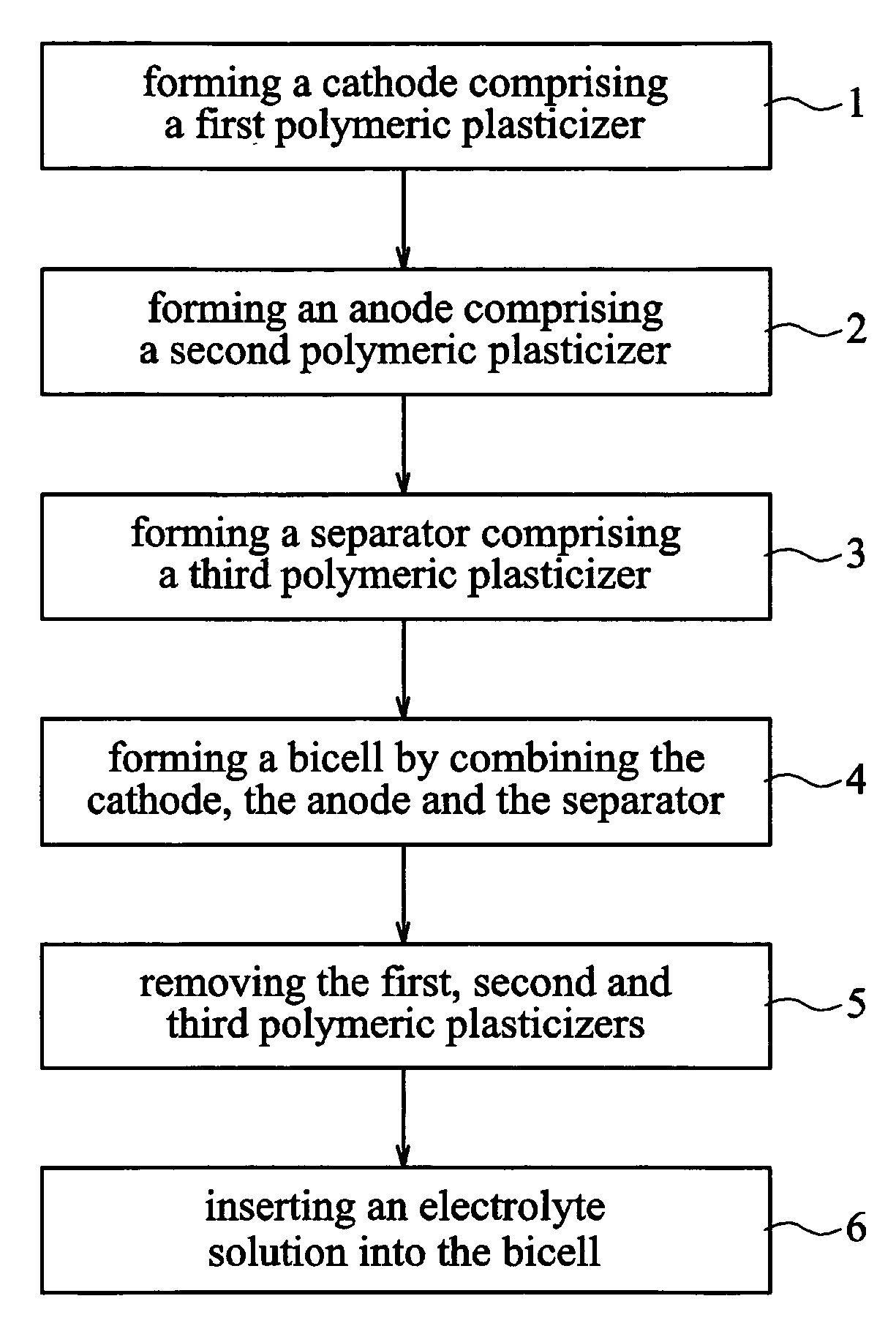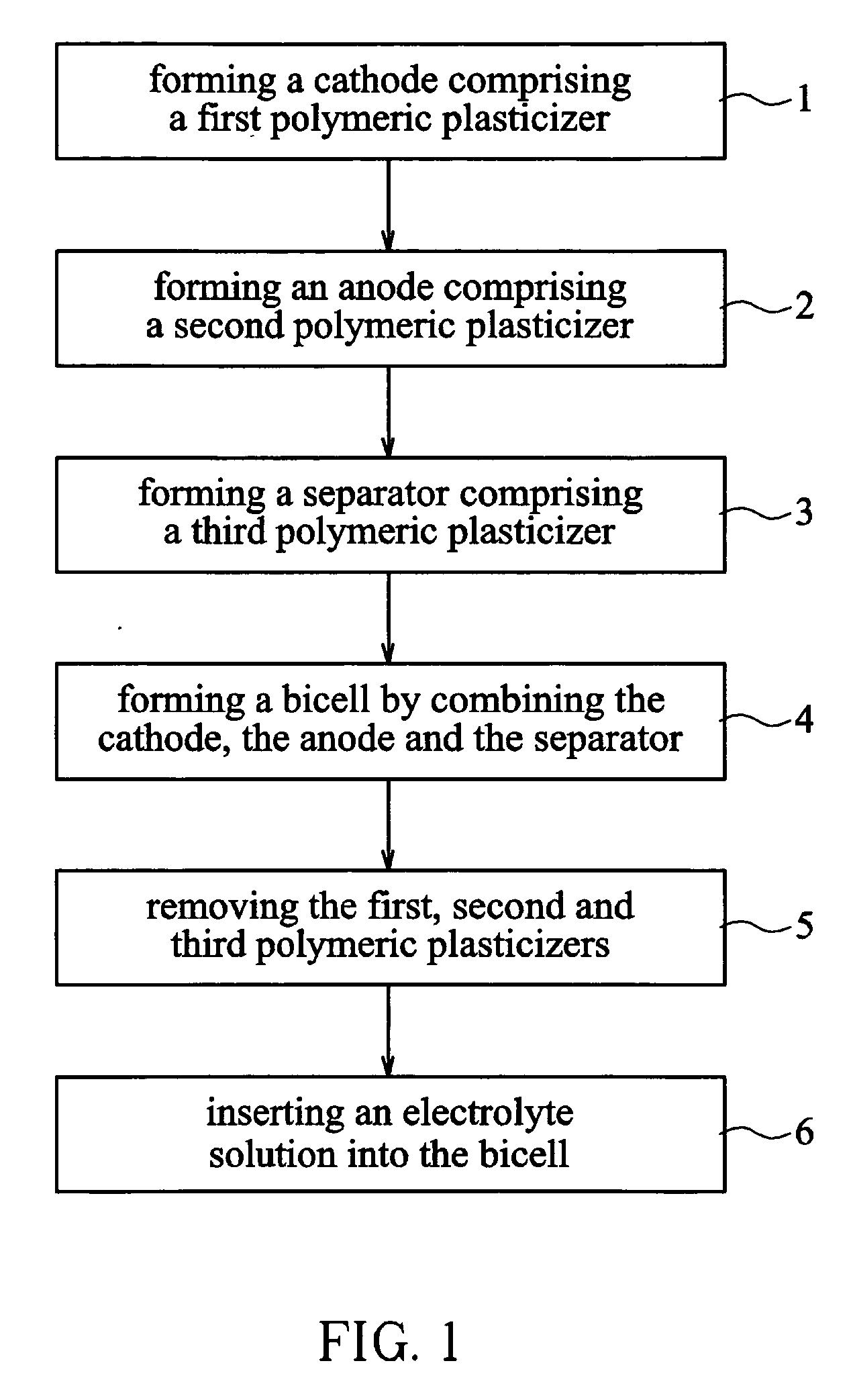Method for producing a lithium polymeric battery cell
a polymer battery and polymer technology, applied in the direction of cell components, final product manufacturing, sustainable manufacturing/processing, etc., can solve the problems of increasing production cost, difficult recycling of dbp dissolved in methanol, and the amount of methanol solvent to completely extract dbp, etc., to achieve easy to obtain, reduce cost, and more durable to voltage
- Summary
- Abstract
- Description
- Claims
- Application Information
AI Technical Summary
Benefits of technology
Problems solved by technology
Method used
Image
Examples
embodiment 1
Using Bisphenol Alkoxylate as Polymeric Plasticizers
[0023] The cathode of the lithium polymeric battery cell is composed of an active material, a conduction auxiliary, a binder, and a polymeric plasticizer (75:5:7:13) by weight. The active material is the mixture of LiCoO2 (LectroPlus 700 manufactured by FMC Corporation) and LiNi0.94Co0.06O2 (1:1) by weight. The conduction auxiliary is conductive carbon black (Super-P manufactured by TIMCAL Graphite & Carbon). The binder is polyvinylidene fluoride (PVDF) (Kynar 2801 manufactured by ATOFINA Chemicals). The polymeric plasticizer is bisphenol alkoxylate (NAC TIC MONATRA 3060 manufactured by GRAN HARM). Acetone is added as a solvent to make cathode paste. Then the cathode paste is coated with blade to 180 g / m2 basis weight to form cathode film. The cathode film is grinded with a cathode collector such as an aluminum net to form a cathode plate.
[0024] The anode of the lithium polymeric battery cell is composed of an active material, a ...
embodiment 2
Using Polyester as Polymeric Plasticizers
[0027] The cathode of the lithium polymeric battery cell in this embodiment is composed of an active material, a conduction auxiliary, a binder, and a polymeric plasticizer (73:4:7:16) by weight. The active material is LiCoO2 (LectroPlus 700 manufactured by FMC Corporation). The conduction auxiliary is conductive carbon black (Super-P manufactured by TIMCAL Graphite & Carbon). The binder is polyvinylidene fluoride (PVDF) (Kynar 2801 manufactured by ATOFINA Chemicals). The polymeric plasticizer is polyester (UNIQEMA priplast 3159). Acetone is added as a solvent to make cathode paste. Then the cathode paste is coated with blade to 180 g / m2 basis weight to form a cathode film. The cathode film is grinded with a cathode collector such as aluminum net to form a cathode plate.
[0028] The anode of the lithium polymeric battery cell is composed of an active material, a conduction auxiliary, a binder, and a polymeric plasticizer (67:2:9:22) by weight...
PUM
| Property | Measurement | Unit |
|---|---|---|
| Electrical conductor | aaaaa | aaaaa |
| Polymeric | aaaaa | aaaaa |
Abstract
Description
Claims
Application Information
 Login to View More
Login to View More - R&D
- Intellectual Property
- Life Sciences
- Materials
- Tech Scout
- Unparalleled Data Quality
- Higher Quality Content
- 60% Fewer Hallucinations
Browse by: Latest US Patents, China's latest patents, Technical Efficacy Thesaurus, Application Domain, Technology Topic, Popular Technical Reports.
© 2025 PatSnap. All rights reserved.Legal|Privacy policy|Modern Slavery Act Transparency Statement|Sitemap|About US| Contact US: help@patsnap.com


